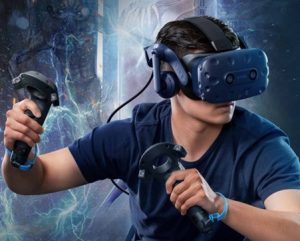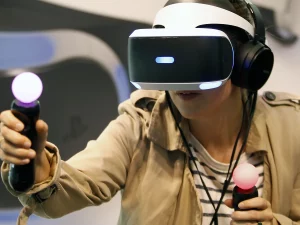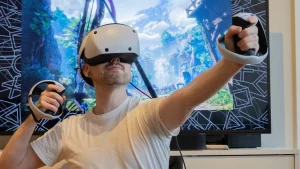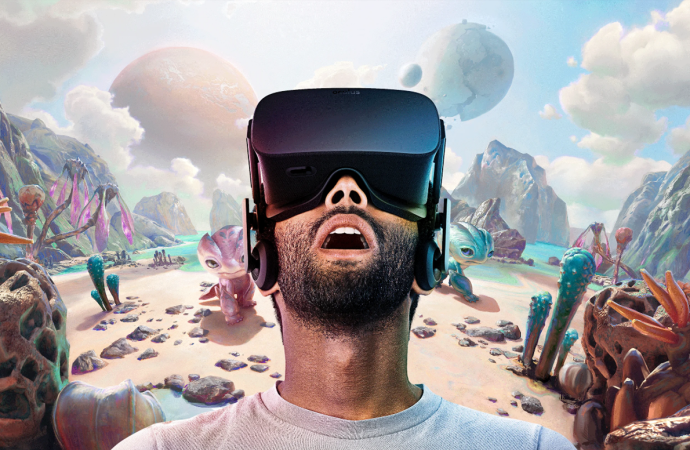Introduction Virtual Reality (VR) Gaming has rapidly evolved from a futuristic concept to a transformative force within the gaming industry. The immersive nature of VR technology has fundamentally changed how players interact with digital environments, offering a level of engagement and realism that traditional gaming platforms cannot match. This article explores the myriad ways in
Introduction
Virtual Reality (VR) Gaming has rapidly evolved from a futuristic concept to a transformative force within the gaming industry. The immersive nature of VR technology has fundamentally changed how players interact with digital environments, offering a level of engagement and realism that traditional gaming platforms cannot match. This article explores the myriad ways in which VR is enhancing gaming experiences, delving into the technology behind VR gaming, its applications, and the future potential of this exciting medium.
The Technology Behind Virtual Reality Gaming

Image by: Yandex.com
- Hardware Components
VR gaming relies on several key hardware components to create immersive experiences:
- Head-Mounted Displays (HMDs): Devices like the Oculus Rift, HTC Vive, and PlayStation VR are equipped with high-resolution screens and motion tracking sensors that provide a 360-degree view of the virtual world.
- Controllers: VR controllers, such as the Oculus Touch and Valve Index controllers, offer precise hand-tracking and haptic feedback, allowing players to interact with virtual objects as if they were real.
- Motion Tracking Systems: These systems use sensors and cameras to track the player’s movements in real-time, ensuring that actions in the physical world are accurately reflected in the virtual environment.
- Computing Power: High-performance PCs or gaming consoles are essential for rendering the complex graphics and physics simulations required for VR gaming.
- Software Components
The software side of VR gaming involves several critical elements:
- Game Engines: Platforms like Unity and Unreal Engine provide the tools and frameworks necessary for developing VR games, offering features like realistic physics, lighting, and sound.
- VR SDKs: Software Development Kits (SDKs) from companies like Oculus and Steam VR offer developers the resources needed to create VR experiences, including APIs for tracking, input, and rendering.
- Content Distribution Platforms: Digital storefronts such as Steam, Oculus Store, and PlayStation Store allow players to purchase and download VR games, fostering a thriving ecosystem for VR content.
Immersive Experiences

Image by: Yandex.com
- Visual Immersion
One of the most significant advantages of VR gaming is the unparalleled level of visual immersion it offers. High-resolution displays and wide field-of-view lenses create a sense of presence, making players feel as though they are truly inside the game world. Advanced graphics and realistic textures further enhance this effect, providing a visually stunning experience.
- Auditory Immersion
Sound plays a crucial role in creating immersive VR experiences. Spatial audio technology allows players to hear sounds from all directions, mimicking how we perceive audio in the real world. This adds depth to the gaming experience, making it easier to locate in-game objects and enemies based on sound cues.
- Physical Immersion
VR gaming goes beyond visual and auditory immersion by incorporating physical interactions. Motion tracking systems and haptic feedback devices enable players to move, touch, and manipulate virtual objects as if they were real. This level of physical engagement creates a more intuitive and natural gaming experience.
Applications of VR in Gaming

Image by: Yandex.com
- First-Person Shooters (FPS)
FPS games have been among the most popular genres in VR gaming. Titles like “Half-Life: Alyx” and “Pavlov VR” leverage VR’s immersive capabilities to create intense and realistic combat scenarios. Players can physically duck behind cover, aim their weapons, and reload, adding a new layer of strategy and excitement to the genre.
- Adventure and Exploration Games
VR is particularly well-suited for adventure and exploration games. Games like “The Elder Scrolls V: Skyrim VR” and “No Man’s Sky VR” allow players to explore vast, open worlds with a sense of presence and scale that is impossible to achieve on traditional screens. The ability to look around and interact with the environment adds depth to the exploration experience.
- Puzzle and Strategy Games
Puzzle and strategy games have also found a home in VR. Titles like “Keep Talking and Nobody Explodes” and “Moss” use VR’s unique capabilities to create engaging and challenging gameplay experiences. Players can manipulate objects, solve puzzles, and strategize in ways that feel more intuitive and immersive.
- Social and Multiplayer Games
VR has the potential to revolutionize social and multiplayer gaming. Platforms like “VRChat” and “Rec Room” offer virtual spaces where players can interact, play games, and socialize with others from around the world. These experiences go beyond traditional online multiplayer, providing a sense of presence and connection that is closer to real-life interactions.
Future Potential of VR Gaming

Image by: Yandex.com
- Improved Hardware
As VR technology continues to advance, we can expect to see improvements in hardware that will enhance the gaming experience. Higher-resolution displays, wider field-of-view lenses, and more accurate motion tracking systems will contribute to even more immersive and realistic VR experiences.
- Expanded Game Libraries
As more developers embrace VR, the library of available VR games will continue to grow. This will provide players with a wider variety of experiences and genres to choose from, further solidifying VR’s place in the gaming industry.
- Integration with Other Technologies
The integration of VR with other emerging technologies, such as augmented reality (AR) and artificial intelligence (AI), holds exciting possibilities for the future of gaming. These technologies can work together to create even more immersive and interactive experiences, blurring the line between the virtual and real worlds.
- Accessibility and Affordability
As VR technology becomes more mainstream, we can expect to see improvements in accessibility and affordability. Lower-priced VR headsets and more user-friendly interfaces will make VR gaming accessible to a broader audience, fostering greater adoption and growth.
Conclusion
Virtual Reality Gaming is revolutionizing the way we experience digital entertainment. By offering unparalleled levels of immersion, interactivity, and realism, VR has the potential to transform the gaming industry and create new opportunities for developers and players alike. As technology continues to advance and the library of VR games expands, the future of VR gaming looks incredibly promising. Whether you’re a seasoned gamer or new to the world of VR, there’s never been a better time to dive into the immersive world of Virtual Reality Gaming.
















